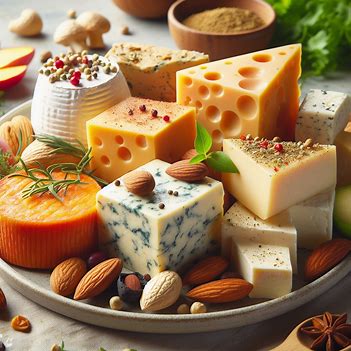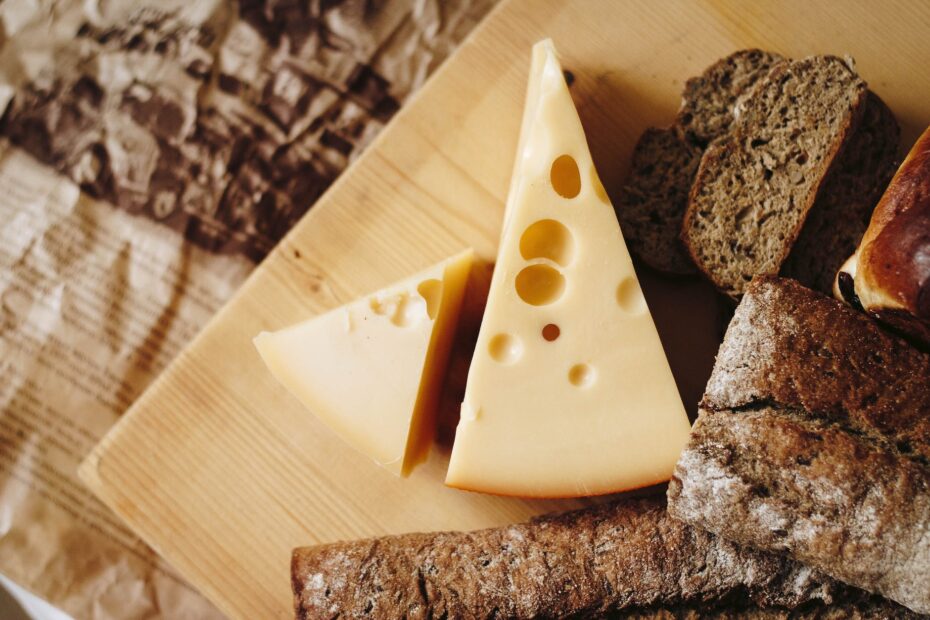Do you have allergies to dairy but crave the taste of cheese? You’re not alone! Luckily, there are various delicious fermented dairy-free cheese substitutes. We’ll investigate the advantages of these substitutes and give tips for eating them.
Introduction
Got allergies? No dairy cheese? No problem! There are plenty of fermented, dairy-free options to satisfy your cravings. Nut-based, soy-based, rice-based, coconut-based, and vegetable-based cheeses are all great substitutions. Plus, many of these are fortified with essential vitamins and minerals, so you don’t miss out on any nutrition.
To find your perfect dairy alternative, experiment with different brands and types. Consider your dietary needs and taste preferences. The ingredients and fermentation process make them a great alternative. Enjoy the complex flavors and healthy bacteria that come with fermentation.
So don’t be blue; dairy-free cheese substitutes made from fermented foods will have you saying ‘cheese’ and ‘thank you, allergies!’
Dairy-Free Cheese Substitutes Made From Fermented Foods

Dairy-free cheese substitutes are a great way to find tasty alternatives to regular cheese. Plus, they offer the benefits of fermented foods! Here’s a list of popular dairy-free cheese substitutes made from fermented foods and their main ingredients:
| Cheese Substitute | Main Ingredients |
| Cashew Cheese | Cashews, Water, Probiotics |
| Coconut Milk Cheese | Coconut Milk, Nutritional Yeast, Lemon Juice |
| Almond Milk Ricotta | Almond Milk, Tapioca Flour, Apple Cider Vinegar |
These substitutes provide a variety of flavors and textures. They’re perfect for dishes like pizzas, pastas, and sandwiches. Plus, they are made from plant-based ingredients instead of animal milk, making them suitable for vegans and those on a plant-based diet.
It’s worth noting that dairy-free cheese substitutes have been around for decades. In response to the growing demand for dairy alternatives, food manufacturers began experimenting with different ingredients and fermentation techniques. Nowadays, these substitutes are popular among those looking for delicious and allergen-free options.
So, if you’re looking for a yummy and allergen-free cheese, try one of these dairy-free cheese substitutes. Pretend it’s made from something else and enjoy!
The Benefits of Fermented Dairy-Free Cheese Substitutes
Fermented dairy-free cheese substitutes provide a tasty, textural alternative to traditional dairy-based cheeses, with plenty of benefits for those with allergies! Here are five key advantages to incorporating such substitutes into your diet:
- Better Digestibility: Fermentation breaks down the complex sugars and proteins in the cheese, making it easier for our bodies to digest. This is especially helpful for those with lactose intolerance or digestive issues.
- Nutritional Value Boost: Fermented dairy-free cheese substitutes contain live cultures that improve gut health, boost nutrient absorption, and strengthen the immune system.
- Allergy Risks Reduced: By eliminating dairy, these alternatives offer a safe choice for those allergic to milk. Plus, they’re free from allergens like lactose and casein.
- Versatility in Cooking: Use these substitutes in an array of recipes without sacrificing flavor or texture. Whether you’re making a creamy pasta dish or a gooey grilled sandwich, these substitutes can deliver.
- Ethical and Environmental Benefits: Choosing fermented dairy-free cheese substitutes supports ethical considerations and has a smaller carbon footprint, making it an environmentally friendly choice.
These substitutes also come in various flavors and textures, and experimenting with different brands and types can open up culinary possibilities. For successful results, start gradually, explore recipe variations, pair with complimentary flavors, consider texture-enhancing techniques, and share experiences and recipes with online communities.
By embracing fermented dairy-free cheese substitutes, individuals with allergies can enjoy delicious cheesy meals without compromising on taste or satisfaction.
The Best Dairy-Free Cheese Substitutes for Those With Allergies
Dairy-free substitutes are here to satisfy your taste buds while keeping you safe. Check out this table for some popular options and their unique features:
| Cheese Substitute | Made From | Unique Feature |
| Cashew Cheese | Ground Cashews | Creamy texture and rich flavor |
| Coconut Milk Cheese | Coconut Milk | Smooth and slightly sweet taste |
| Soy Cheese | Soybeans | High in protein and melts well when heated |
| Almond Cheese | Almonds | Nutty flavor and perfect for spreading on crackers |
Looking for more? Rice-based cheese is made from fermented rice milk and has a mild flavor. Potato-based cheese offers a similar texture to traditional cheese and melts nicely.
When choosing, consider your dietary needs and preferences. Cashew cheese is creamy and rich. Coconut milk cheese is smooth and sweet. Soy cheese is high in protein and melts great. Almond cheese has a nutty flavor that pairs well with crackers or bread.
Explore the world of dairy-free cheeses and indulge in delicious flavors that enhance any dish. Don’t forget: no more tears in your cheese!
The Different Types of Dairy-Free Cheese
Dairy-free cheese substitutes offer a great option for those with allergies. Let’s explore the various types and their unique qualities!
Cashew cheese is creamy and smooth with a nutty taste.
Coconut milk cheese has a creamy and velvety texture with a mildly sweet flavor.
Almond cheese is more firm and crumbly, with a mild taste, and it melts!
There are even more options out there, like soy-based cheese, rice-based cheese, and hemp seed-based cheese. All of these provide versatility and cater to different dietary requirements. Now you can enjoy delicious cheese flavors without dairy! Try these dairy-free cheese substitutes and discover a world of new tastes. Go ahead and indulge in the surprisingly convincing texture and flavor—who needs lactose when you can have lactose-free fun?
The Taste and Texture of Dairy-Free Cheese Substitutes

Say cheese, vegans! Discover dairy-free cheese substitutes and never suffer from cheesy-fueled FOMO again. We’ve compiled a table to help you explore these alternatives. Here’s a breakdown of the taste and texture of each:
| Cheese Substitute | Taste | Texture |
| Cashew Cheese | Creamy | Smooth |
| Almond Cheese | Nutty | Firm |
| Coconut Milk Cheese | Mild | Soft |
| Soy-based Cheese | Savory | Melts easily |
| Rice Milk Cheese | Neutral | Crumbly |
Remember, some dairy-free cheese substitutes may have slightly different tastes and textures than regular cheese. Consider your personal preferences and dietary needs when choosing which one to try.
When using these substitutes in dishes, you may need to make slight adjustments. For example, cashew or almond cheese can be used as toppings on pizza or sandwiches. Soy-based cheeses are great for melting on grilled sandwiches or pasta.
In conclusion, dairy-free cheese substitutes offer a range of culinary possibilities. Consider the taste and texture of each, find the perfect one, and enjoy all the cheesy delights without compromising your dietary restrictions.
How to Make Your Own Dairy-Free Cheese
Are you avoiding dairy? Now, you can enjoy cheesy goodness without feeling left out. Making dairy-free cheese substitutes is easier than ever before! Here’s a step-by-step guide to help you get started:
- Choose a Base Ingredient: Cashews, almonds, or tofu are all great non-dairy options.
- Soak and Blend: Soak your base ingredient overnight and blend with water, nutritional yeast, and seasonings until smooth.
- Add Thickening Agents: To make the mixture thicker, add agar-agar or tapioca starch while heating it on the stove.
- Flavor and Season: Add garlic powder, herbs, lemon juice, or miso paste to taste. Experiment with different combinations to find your favorite.
- Let It Set and Enjoy: Pour the mixture into molds and refrigerate until firm. Once set, slice or grate your homemade dairy-free cheese substitute as needed.
Note that each base ingredient will give your final product its own unique flavor and texture. You can also explore variations using nuts, soybeans, or vegetables like cauliflower or zucchini.
Did you know that dairy-free cheese substitutes have a long history? Back in ancient times, cultures such as the Romans used soaked nuts blended with honey as a replacement for traditional cheeses. Through the years, this practice has spread across various culinary traditions worldwide.
So, say ‘cheese’ and try not to cry. Dairy-free substitutes can still turn your recipes into cheesy masterpieces!
Tips for Using Dairy-Free Cheese Substitutes in Recipes
Let’s explore the benefits of making our own dairy-free cheese substitutes and avoid any cheesy situations. Here are some helpful tips for incorporating these substitutes into your dishes:
- Choose the right substitute:
- Look for dairy-free cheeses that melt well and have a similar texture to regular cheese.
- Experiment with different brands and types to find the one that best suits your taste and recipe.
- Adjust the amount.
- Dairy-free cheeses can sometimes have a stronger flavor than regular cheese.
- Start by using a smaller amount, and gradually increase or decrease the quantity based on your preference and the dish you’re making.
- Add flavorful ingredients:
- Enhance the taste of dairy-free cheese substitutes by adding herbs, spices, or other flavorful ingredients to your recipes.
- This will help balance out any differences in taste and create a more enjoyable culinary experience.
- Consider Texture:
- Dairy-free cheese substitutes may have a slightly different texture than traditional cheese.
- Try grating or shredding the substitute before using it in recipes, rather than using it in block form.
- Try different cooking techniques:
- Explore various cooking techniques like baking, broiling, or melting to optimize the taste and texture of dairy-free cheeses.
- Each method may yield different results, so don’t be afraid to experiment and find what works best for you.
By following these tips, you can successfully incorporate dairy-free cheese substitutes into your favorite recipes while still enjoying delicious flavors. Remember to adjust quantities, add flavor enhancers, and experiment with cooking techniques to achieve satisfying results every time!
The Benefits of Making Your Own Dairy-Free Cheese
Making your own dairy-free cheese substitute has many benefits. You have control over the ingredients; you can experiment with flavors and textures; it can save you money and you help reduce packaging waste. Plus, you can customize the level of tanginess or creaminess to your liking. Additionally, it’s an exciting culinary adventure to incorporate herbs, spices, or even veggies into the mix.
Recently, due to the growing number of individuals with lactose intolerance or allergies, recipes for dairy-free cheese substitutes emerged. You can find many recipes online and in cookbooks. Don’t worry if you make mistakes; troubleshooting dairy-free cheese substitutes is like solving a Rubik’s cube, but tastier!
Troubleshooting Dairy-Free Cheese Substitutes
Searching for a dairy-free cheese alternative can be tricky. Here’s how to simplify the hunt:
- Pick the right substitute – go for something that has a texture and flavor similar to dairy cheese. Soy, nut, or coconut milk-based products usually provide a creamy texture.
- Test different brands and types – not all dairy-free cheeses are the same. Give a few brands and types a try to find what suits your taste buds the best.
- Get melting – some dairy-free cheeses don’t melt as well as traditional dairy-based ones. To get that perfect texture, shred or slice thinly and apply gentle heat.
- Boost the flavor – dairy-free cheeses can lack the flavor of classic cheeses. Add herbs, spices, or nutritional yeast for an extra kick.
- Try homemade options – explore recipes online or in specialty cookbooks and try making your own dairy-free cheese. This way, you get to control the ingredients and create something unique.
If finding the right dairy-free cheese substitute is taking too long, don’t despair. With some effort and ingenuity, you’ll find what you’re looking for.
Remember: Everyone has different dietary requirements, so always read the labels carefully before buying.
Conclusion
Dairy-free cheese substitutes are a great pick for those with allergies or dietary restrictions. They offer the same creamy texture and flavor as traditional cheese, sans the downsides. There’s a wide range of options, so individuals can dig into a delicious dairy-free alternative that suits their taste and nutritional needs.
When selecting a dairy-free cheese, some things to consider include: what recipe or dish you’ll be using it in; your personal taste preferences; and the ingredient list. Opt for natural, whole-food ingredients without artificial flavors or preservatives. Many brands now offer lactose-free alternatives that still provide the same great taste and texture.
Don’t be afraid to experiment! Trying out different dairy-free cheese substitutes can be a fun and yummy adventure. You may find new flavors and textures you never knew existed. Plus, according to Healthline, certain dairy-free cheeses, such as those made from cashews or almonds, can supply the healthy fats and proteins required for a balanced diet!
FAQs About Dairy-Free Cheese Substitutes
What are fermented dairy-free cheese substitutes?
Fermented dairy-free cheese substitutes are plant-based alternatives to traditional cheese that are made through a fermentation process. These substitutes are free from dairy products and are suitable for individuals with allergies or dietary restrictions.
How are fermented dairy-free cheese substitutes made?
Fermented dairy-free cheese substitutes are typically made by blending a combination of plant-based ingredients, such as nuts, seeds, or tofu with probiotics. The mixture is then fermented to develop a tangy, cheese-like flavor and texture.
Are fermented dairy-free cheese substitutes suitable for people with lactose intolerance?
Yes, fermented dairy-free cheese substitutes are an excellent option for individuals with lactose intolerance. These substitutes do not contain lactose, the sugar found in dairy products, making them easier to digest for those with lactose intolerance.
Can fermented dairy-free cheese substitutes be used as a one-to-one replacement for traditional cheese?
Fermented dairy-free cheese substitutes can be used in various recipes as a replacement for traditional cheese. However, it’s important to note that they may have a slightly different taste and texture, so experimentation may be needed to find the best match for specific dishes.
Do fermented dairy-free cheese substitutes offer the same nutritional benefits as traditional cheese?
Fermented dairy-free cheese substitutes can provide similar nutritional benefits to traditional cheese, depending on the ingredients used. They can be a good source of plant-based protein, healthy fats, vitamins, and minerals. However, it’s always recommended to read the product labels to ensure the specific nutritional content.
Where can I find fermented dairy-free cheese substitutes?
Fermented dairy-free cheese substitutes are becoming increasingly popular, and they can be found in many health food stores, specialty grocery stores, and even some mainstream supermarkets. They are also available for purchase online for convenient delivery to your doorstep.

